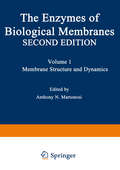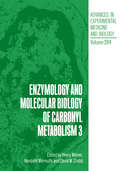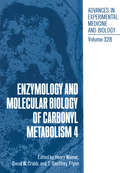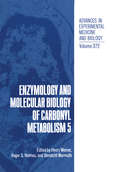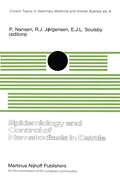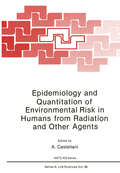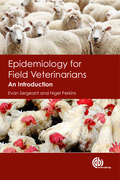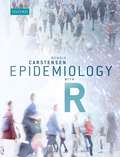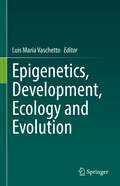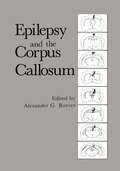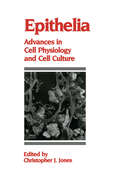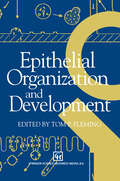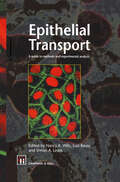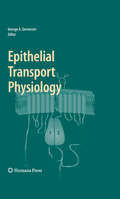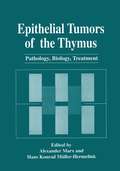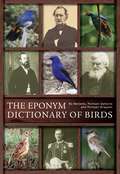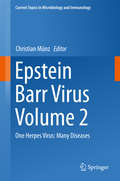- Table View
- List View
The Enzymes of Biological Membranes: Volume 1 Membrane Structure and Dynamics
by A. N. MartonosiIn the first edition of The Enzymes of Biological Membranes, published in four volumes in 1976, we collected the mass of widely scattered information on membrane-linked enzymes and metabolic processes up to about 1975. This was a period of transition from the romantic phase of membrane biochemistry, preoccupied with conceptual developments and the general properties of membranes, to an era of mounting interest in the specific properties of membrane-linked enzymes analyzed from the viewpoints of modem enzymology. The level of sophistication in various areas of membrane research varied widely; the structures of cytochrome c and cytochrome b5 were known to atomic detail, while the majority of membrane-linked enzymes had not even been isolated. In the intervening eight years our knowledge of membrane-linked enzymes ex panded beyond the wildest expectations. The purpose of the second edition of The Enzymes of Biological Membranes is to record these developments. The first volume describes the physical and chemical techniques used in the analysis of the structure and dynamics of biological membranes. In the second volume the enzymes and met abolic systems that participate in the biosynthesis of cell and membrane components are discussed. The third and fourth volumes review recent developments in active transport, oxidative phosphorylation and photosynthesis.
Enzymes of the Cholinesterase Family
by A. S. Balasubramanian Bhupendra P. Doctor Daniel M. Quinn Palmer TaylorThe Fifth International Meeting on Cholinesterases convened in Madras, India, in September of 1994. The long and rich history and culture of India provided an excellent setting for the meeting. More than 120 delegates from Asia, Australia, Europe and North America heard 54 oral presentations and viewed 54 posters on current research on enzymes of the cholinesterase family. The aim of this book is to compile the presentations of the Fifth International Meeting on Cholinesterases into a volume that describes recent investigations on the structure and catalytic function of acetylcholinesterase (AChE), butyrylcholinesterase (BuChE) and related enzymes, as well as studies on the molecular and cellular biology of these enzymes and the genes which encode them. Cholinesterases enjoy a long and storied history in diverse areas. In basic biochemical research, AChE is one of the best studied, though yet enigmatic, of enzymes. The efficient catalytic function of this enzyme presents the biochemist with a fundamental challenge in understanding the relationship between structure and function. AChE and BuChE belong to a family of proteins, the alB hydrolase fold family, whose constituents evolutionarily diverged from a common ancestor. Proteins in this family have a wide range of physiological functions. In commerce, AChE is a prime target for agricultural insect control, and for the development of therapeutic agents for Alzheimer's disease.
Enzymology and Molecular Biology of Carbonyl Metabolism 3 (Advances in Experimental Medicine and Biology #284)
by David W. Crabb Henry Weiner Bendicht WermuthThe Fifth International Workshop on the Enzymology and Molecular Biology of Carbonyl Metabolism was held at Purdue University in June, 1990. This represents the fifth time that I had the privilege of organizing the scientific program. It was the first time that I actually hosted the meeting. I wish to salute my four previous co-organizers and the thousands of scientists who have hosted other meetings. It is much easier to arrange the scientific program and edit the proceedings. No local organization could occur without the help of ones research group and, in this case, my wife. I sincerely thank Esther and my research group for their advise and help. At this Workshop, similar to the preceeding ones, much new information was presented. It was apparent how molecular biological techniques were influencing the direction of the research on the three families of enzymes discussed. It also was apparent that not all biochemical problems could be solved by using these techniques. Many of the presentations showed how important advances still could be made using more traditional biochemical approaches.
Enzymology and Molecular Biology of Carbonyl Metabolism 4 (Advances in Experimental Medicine and Biology #328)
by Henry Weiner David W. Crabb T. Geoffrey FlynnThe Sixth International Workshop on the Enzymology and Molecular Biology of Carbonyl Metabolism was held outside of Dublin, Ireland at the end of June, 1992. Prof. Keith Tipton, Chairman of the Biochemistry Department at Trinity College, kindly agreed to host the meeting. On behalf of all of us who attended I wish to extend our sincere thanks to the whole Tipton family for making us feel so welcome in Ireland. It has been a decade since the frrst workshop was held in Bern, Switzerland. The scope of the meetings reflected somewhat the changes that have occurred in biochemistry during the past decade. At the first meeting primarily enzymes and their properties were discussed. At this last meeting many of the talks centered on gene regulation as well as more traditional aspects of enzymology and metabolism. During the past decade site directed mutagenesis to probe for the active site of an enzyme has become part of traditional enzymology; this was virtually unheard of at our frrst meeting. Many of the presenters now used this tool to study some aspect of structure and function of one of the three carbonyl metabolizing enzymes.
Enzymology and Molecular Biology of Carbonyl Metabolism 5 (Advances in Experimental Medicine and Biology #372)
by Henry Weiner Roger S. Holmes Bendicht WermuthSince the inception of these meetings in 1982, they have always been a satellite of the International Society for Biomedical Research on Alcoholism meeting. At our 1992 meeting in Dublin we learned that the next ISBRA meeting would be held in Brisbane, of all our previous meetings, I was very concerned Australia. As the scientific organizer about holding a meeting in the Southern Hemisphere for fear that many of our potential participants would not travel that far. I am pleased to say that I was proven to be incorrect. Nearly 90 scientists from a dozen countries participated at our seventh conference. At this meeting, like at all our previous ones, much new information about the three enzyme systems was presented. Of equal importance was, like at all our previous meetings, the extreme openness of the participants to discuss ideas, future directions and unpublished data. On behalf of all the participants I wish to express our sincere thanks to our Massey University colleagues for the excellent organization of this Palmerston North, New Zealand meeting. These included Kathryn Kitson, Michael Hardman, Paul Buckley, Trevor Kitson and Len Blackwell. At this meeting a few new innovations were introduced. Though posters are common at many meetings, bush walks and visits to nature preserves to see kiwi birds Our hosts were able to secure support from the International Union of Biochemistry are not.
Epidemiology and Control of Nematodiasis in Cattle: An Animal Pathology in the CEC Programme of Coordination of Agricultural Research, held at the Royal Veterinary and Agricultural University, Copenhagen, Denmark, February 4–6, 1980 (Current Topics in Veterinary Medicine #9)
by E. J. L.Soulsby R. JessJørgensen P. NansenThis publication is the Proceedings of a workshop held at the Royal Veterinary and Agricultural University in Copenhagen, Denmark on 4th - 6th February, 1980, sponsored by the Commission of the EUropean Communities (CEO) as a part of the programme of coordination of agricultural research in the field of animal pathology. The CEO wishes to thank those who took responsibility for the organisation of the workshop, those who presented the papers, and all participants. VII CONTENTS SESSION I METHODOLOGY I MONITORING PASTURE INFECTIVITY AND PASTURE CONTAMINATION WITH INFECTIVE STAGES OF Dictyocaulus viviparus 3 R. J. J¢rgensen THE CORRECT HANDLING OF FAECAL SAMPLES USED FOR EXAMINATION OF Dictyocaulus viviparus LARVAE 11 H. J. W. M. Cremers SOME EFFECTS OF STORAGE ON THE RECOVERY OF Dictyocaulus viviparus LARVAE FROM FAECES 17 M. T. Fox EXPERIENCES WITH OUR TECHNIQUES FOR THE RECOVERY OF NEMATODE LARVAE FROM HERBAGE H. -J. Burger 25 A TECHNIQUE FOR THE RECOVERY OF INFECTIVE TRICHOSTRONGYLE LARVAE FROM SOIL 31 K. Bairden, J. L. Duncan and J. Armour SESSION I METHODOLOGY II A MODIFIED AND SIMPLE MCMASTER TECHNIQUE 45 Sv. Aa. Henriksen COMPARISON OF TECHNIQUES FOR ASSESSMENT OF THE CONTAMINATION OF PASTURE HERBAGE WITH INFECTIVE NEMATODE LARVAE 51 J. -P. Raynaud and L. Gruner RECOVERY OF Ostertagia FROM THE BOVINE ABOMASAL MUCOSA BY IMMERSION IN WARM NORMAL SALINE 69 N. E. Downey CONTROLLED/CRITICAL TESTS IN THE EVALUATION OF ANTHELMINTIC ACTIVITY 75 D. D{;.
Epidemiology and Quantitation of Environmental Risk in Humans from Radiation and Other Agents (Nato ASI Subseries A: #96)
by A. CastellaniThe identification and quantitation of environmental risk in humans is one of the main problems to be solved in order to improve the protection of individuals and of human populations against phys ical and chemical pollutants. Epidemiology plays a central role in the evaluation of health risk directly in human populations. In this volume are collected 33 lectures presented at the AS! course on "Epidemiology and quanti tat ion of environmental risk in humans from radiation and other agents: potential and limitations", sponsored by NATO and Italian Association of Radiobiology and or ganized by ENEA. The course has been devoted to a number of aspects of environ mental risk analysis and evaluation based on epidemiological in vestigation. Basic epidemiological concepts and methods have been reviewed. Fundamentals of dosimetry and microdosimetry were presented in re lation to the contribution of epidemiology in defining the dose effect relationships for radiation carcinogenesis and its relation with age, sex and ethnicity. The mechanisms of carcinogenesis as a multi-stage process were illustrated. One of the main topics was 'cancer epidemiology' and its cor relation with: - occupational and non-occupational exposure to ra diation - diagnostic and therapeutic irradiation - cancer proneness - hereditary and familiar diseases - abnormal response to carcino gens - environmental pollution in air and water - exposure to radon in mines and in building material - atomic bomb explosion - chemo therapy - dioxin and related compounds.
Epidemiology for Field Veterinarians: An Introduction
by Evan Sergeant Nigel PerkinsIntended as an introduction for veterinarians and other animal health professionals interested in and wishing to apply epidemiological methods in their day-to-day work, this book provides a practical guide for those new to the field. Its applied focus covers the principles of epidemiology in real world situations and practical implementation of disease outbreak investigation, for both emerging and endemic diseases. Techniques and methods are discussed, supported by case studies and practical examples to illustrate their application. The book is clearly written and accessible, providing readers with practical information and encouraging the development of problem-solving skills. It is an essential handbook for veterinary surgeons and students and those involved in animal health, food safety and epidemiology.
Epidemiology with R
by Bendix CarstensenThis practical guide is designed for students and researchers with an existing knowledge of R who wish to learn how to apply it in an epidemiological context and exploit its versatility. It also serves as a broader introduction to the quantitative aspects of modern practical epidemiology. The standard tools used in epidemiology are described and the practical use of R for these is clearly explained and laid out. R code examples, many with output, are embedded throughout the text. The entire code is also available on the companion website so that readers can reproduce all the results and graphs featured in the book. Epidemiology with R is an advanced textbook suitable for senior undergraduate and graduate students, professional researchers, and practitioners in the fields of human and non-human epidemiology, public health, veterinary science, and biostatistics.
Epigenetics, Development, Ecology and Evolution
by Luis María VaschettoEpigenetic modifications comprise heritable gene expression changes that occur without alteration of the DNA sequence and 'co-act' with genetic factors to shape development processes and evolutionary trajectories. Multicellular organisms receive different types of environmental stimuli/stresses that trigger epigenetic modifications during development. These environmentally driven mechanisms represent an underlying cause of phenotypic diversity, especially in metazoans. This book aims to present some of the latest epigenetic insights into the development of metazoans (including humans) as an intersection between their ecology and evolution.
Epilepsy and the Corpus Callosum
by Alexander G. ReevesInJuly 1982 the first Dartmouth workshop on the corpus callosum took place. A nucleus of basic and clinical scientists was convened to give progress reports of their work on the corpus callosum. This text was subsequently compiled by the various participants from these reports modified by a stimulating cross fertilization of ideas and subsequent studies. Four and one-half decades have intervened since Van Wagenen first sectioned the corpus callosum for epilepsy (Van Wagenen and Herren, 1940) and Erickson (1940) demonstrated that the corpus callosum is the major route for generalization of experimentally induced focal cortical epilepsy. During the succeeding 45 years a handful of clinicians has pursued these leads to confirm the therapeutic value of callosotomy for some types of medically intractable generalized epilepsy. Parallel experimental studies with a number of epilepsy models have indicated that the corpus callosum is indeed the major route for seizure generalization, that the brainstem is a secondary and more resistant pathway for seizure generalization, and that most if not all epileptic seizures originate from the cerbral cortex. The unexpected clinical finding that even partial (focal) seizure incidence is modified by callosotomy now has been demonstrated in the laboratory. The various contributors to the clinical and experimental epilepsy sections of this volume have been seminal in these elucidations, as will be evident from their chapters. The section on the development, anatomy, and physiology of the corpus callosum demonstrates that these basic areas of study have not been neglected.
Epithelia: Advances in Cell Physiology and Cell Culture
by C. J. JonesEpithelial cells probably constitute the most diverse group of cells found in the body. In addition to serving as interfaces between external and internal environments, their functions include ion and fluid secretion and reabsorp tion, protein exocytosis, hormone secretion, recognition, surface protection and the control of ciliary movement. By their very exposure on the surfaces of the body, epithelial cells are subjected to wide-ranging assault, by micro organisms and by chemical and physical forces. They are the targets for abrasion, infection and malignant transformation. Some epithelial cells show altered behaviour in inherited syndromes, such as cystic fibrosis, characterized by serious pancreatic and pulmonary disease. In view of the importance of epithelia and the fact that their function can be altered by environmental and inherited factors, they are the subject of intensive research, particularly so in the case of cancer where most tumours are of epithelial origin. The use of animal tissues in epithelial research continues to provide important advances and this, coupled with the need to focus more on human tissues, has prompted a greater research emphasis on accessible human epithelia and on the establishment of cell cultures from animal and human sources. For primary cell cultures and cell lines to be of value, they need to express properties appropriate to their progenitors and relevant to the study in progress.
Epithelial Organization and Development
by T. P. FlemingEpithelia are one of the commonest tissue types in the animal kingdom. Chapters from leading scientists in the major international research laboratories use examples from different systems to illustrate the form and function of epithelia. An important theme is the way in which epithelial cells differentiate to specialized tissue - reversal of this process occurs when cells become tumorigenic.
Epithelial Transport: A guide to methods and experimental analysis
by N.K. Wills L. Reuss S.A. LewisBuilding from general principles, the authors clearly explain the fundamental role of epithelia in plasma electrolyte and water balance. Emphasis is placed on experimental approaches and methodology. A comprehensive glossary of terms is included.
Epithelial Transport Physiology
by George A. GerencserBiological cell membranes regulate the transfer of matter and information between the intracellular and extracellular compartments as basic survival and maintenance functions for an organism. This volume contains a series of reviews that are c- cerned with how epithelial plasma membranes regulate the transport of solutes between the intracellular and extracellular compartments of a cell. This book is also an attempt to analyze the molecular basis for the movement of various solutes across an epithelial cell membrane. This volume is devoted to a diversity of epithelial transport mechanisms in rep- sentative cell membranes of a variety of living things. The ?rst section of the book (Chapters 1–6) focuses on mechanisms of solute transport in epithelia of inver- brates. The last section which comprises ten chapters (Chapters 7–16) deals with solute transporters in epithelial cell membranes of vertebrates. It is hoped that with this particular ordering the reader can glean a telescopic view of the evolutionary history of the various epithelial solute transporters.
Epithelial Tumors of the Thymus: Pathology, Biology, Treatment
by Alexander Marx Hans Konrad Müller-HermelinkProceedings of the First Conference on the Biological and Clinical Aspects of Thymic Epithelial Tumors held in Würzburg, Germany, April 14-18, 1996
The Eponym Dictionary of Birds
by Bo Beolens Michael Watkins Michael GraysonBirdwatchers often come across bird names that include a person's name, either in the vernacular (English) name or latinised in the scientific nomenclature. Such names are properly called eponyms, and few people will not have been curious as to who some of these people were (or are).Names such as Darwin, Wallace, Audubon, Gould and (Gilbert) White are well known to most people. Keener birders will have yearned to see Pallas's Warbler, Hume's Owl, Swainson's Thrush, Steller's Eider or Brünnich's Guillemot. But few people today will have even heard of Albertina's Myna, Barraband's Parrot, Guerin's Helmetcrest or Savigny's Eagle Owl. This extraordinary new work lists more than 4,000 eponymous names covering 10,000 genera, species and subspecies of birds. Every taxon with an eponymous vernacular or scientific name (whether in current usage or not) is listed, followed by a concise biography of the person concerned. These entries vary in length from a few lines to several paragraphs, depending on the availability of information or the importance of the individual's legacy. The text is punctuated with intriguing or little-known facts, unearthed in the course of the authors' extensive research.Ornithologists will find this an invaluable reference, especially to sort out birds named after people with identical surnames or in situations where only a person's forenames are used. But all birders will find much of interest in this fascinating dictionary, an ebook to dip into time and time again whenever their curiosity is aroused.
The Eponym Dictionary of Birds
by Bo Beolens Michael Watkins Michael GraysonBirdwatchers often come across bird names that include a person's name, either in the vernacular (English) name or latinised in the scientific nomenclature. Such names are properly called eponyms, and few people will not have been curious as to who some of these people were (or are).Names such as Darwin, Wallace, Audubon, Gould and (Gilbert) White are well known to most people. Keener birders will have yearned to see Pallas's Warbler, Hume's Owl, Swainson's Thrush, Steller's Eider or Brünnich's Guillemot. But few people today will have even heard of Albertina's Myna, Barraband's Parrot, Guerin's Helmetcrest or Savigny's Eagle Owl. This extraordinary new work lists more than 4,000 eponymous names covering 10,000 genera, species and subspecies of birds. Every taxon with an eponymous vernacular or scientific name (whether in current usage or not) is listed, followed by a concise biography of the person concerned. These entries vary in length from a few lines to several paragraphs, depending on the availability of information or the importance of the individual's legacy. The text is punctuated with intriguing or little-known facts, unearthed in the course of the authors' extensive research.Ornithologists will find this an invaluable reference, especially to sort out birds named after people with identical surnames or in situations where only a person's forenames are used. But all birders will find much of interest in this fascinating volume, a book to dip into time and time again whenever their curiosity is aroused.
Epstein Barr Virus Volume 2: One Herpes Virus: Many Diseases (Current Topics in Microbiology and Immunology #391)
by Christian MünzEpstein Barr virus (EBV) was discovered as the first human tumor virus around 50 years ago. Since its discovery in Burkitt’s lymphoma it has been associated with various other malignancies, infectious mononucleosis and even autoimmune diseases. The two book volumes on EBV summarize the first 50 years of research on this tumor virus, starting with historical perspectives on discovery, oncogenicity and immune control, reviewing the role that the virus plays in the various associated diseases and concluding with a discussion on how the immune system keeps persistent EBV infection under control in healthy EBV carriers and can be used to treat EBV associated diseases. The respective 32 chapters are written by international experts from three continents for health care providers, biomedical researchers and patients that are affected by EBV. The assembled knowledge should help to understand EBV associated diseases better and to develop EBV specific vaccination in the near future.
Equestrian Cultures: Horses, Human Society, and the Discourse of Modernity (Animal Lives)
by Kristen Guest Monica MattfeldAs much as dogs, cats, or any domestic animal, horses exemplify the vast range of human-animal interactions. Horses have long been deployed to help with a variety of human activities—from racing and riding to police work, farming, warfare, and therapy—and have figured heavily in the history of natural sciences, social sciences, and the humanities. Most accounts of the equine-human relationship, however, fail to address the last few centuries of Western history, focusing instead on pre-1700 interactions. Equestrian Cultures fills in the gap, telling the story of how prominently horses continue to figure in our lives, up to the present day. Kristen Guest and Monica Mattfeld place the modern period front and center in this collection, illuminating the largely untold story of how the horse has responded to the accelerated pace of modernity. The book’s contributors explore equine cultures across the globe, drawing from numerous interdisciplinary sources to show how horses have unexpectedly influenced such distinctively modern fields as photography, anthropology, and feminist theory. Equestrian Cultures boldly steps forward to redefine our view of the most recent developments in our long history of equine partnership and sets the course for future examinations of this still-strong bond.
Equestrian Cultures: Horses, Human Society, and the Discourse of Modernity (Animal Lives)
by Kristen Guest Monica MattfeldAs much as dogs, cats, or any domestic animal, horses exemplify the vast range of human-animal interactions. Horses have long been deployed to help with a variety of human activities—from racing and riding to police work, farming, warfare, and therapy—and have figured heavily in the history of natural sciences, social sciences, and the humanities. Most accounts of the equine-human relationship, however, fail to address the last few centuries of Western history, focusing instead on pre-1700 interactions. Equestrian Cultures fills in the gap, telling the story of how prominently horses continue to figure in our lives, up to the present day. Kristen Guest and Monica Mattfeld place the modern period front and center in this collection, illuminating the largely untold story of how the horse has responded to the accelerated pace of modernity. The book’s contributors explore equine cultures across the globe, drawing from numerous interdisciplinary sources to show how horses have unexpectedly influenced such distinctively modern fields as photography, anthropology, and feminist theory. Equestrian Cultures boldly steps forward to redefine our view of the most recent developments in our long history of equine partnership and sets the course for future examinations of this still-strong bond.
Equestrian Cultures: Horses, Human Society, and the Discourse of Modernity (Animal Lives)
by Kristen Guest Monica MattfeldAs much as dogs, cats, or any domestic animal, horses exemplify the vast range of human-animal interactions. Horses have long been deployed to help with a variety of human activities—from racing and riding to police work, farming, warfare, and therapy—and have figured heavily in the history of natural sciences, social sciences, and the humanities. Most accounts of the equine-human relationship, however, fail to address the last few centuries of Western history, focusing instead on pre-1700 interactions. Equestrian Cultures fills in the gap, telling the story of how prominently horses continue to figure in our lives, up to the present day. Kristen Guest and Monica Mattfeld place the modern period front and center in this collection, illuminating the largely untold story of how the horse has responded to the accelerated pace of modernity. The book’s contributors explore equine cultures across the globe, drawing from numerous interdisciplinary sources to show how horses have unexpectedly influenced such distinctively modern fields as photography, anthropology, and feminist theory. Equestrian Cultures boldly steps forward to redefine our view of the most recent developments in our long history of equine partnership and sets the course for future examinations of this still-strong bond.
Equestrian Cultures: Horses, Human Society, and the Discourse of Modernity (Animal Lives)
by Kristen Guest Monica MattfeldAs much as dogs, cats, or any domestic animal, horses exemplify the vast range of human-animal interactions. Horses have long been deployed to help with a variety of human activities—from racing and riding to police work, farming, warfare, and therapy—and have figured heavily in the history of natural sciences, social sciences, and the humanities. Most accounts of the equine-human relationship, however, fail to address the last few centuries of Western history, focusing instead on pre-1700 interactions. Equestrian Cultures fills in the gap, telling the story of how prominently horses continue to figure in our lives, up to the present day. Kristen Guest and Monica Mattfeld place the modern period front and center in this collection, illuminating the largely untold story of how the horse has responded to the accelerated pace of modernity. The book’s contributors explore equine cultures across the globe, drawing from numerous interdisciplinary sources to show how horses have unexpectedly influenced such distinctively modern fields as photography, anthropology, and feminist theory. Equestrian Cultures boldly steps forward to redefine our view of the most recent developments in our long history of equine partnership and sets the course for future examinations of this still-strong bond.
Equestrian Cultures: Horses, Human Society, and the Discourse of Modernity (Animal Lives)
by Kristen Guest Monica MattfeldAs much as dogs, cats, or any domestic animal, horses exemplify the vast range of human-animal interactions. Horses have long been deployed to help with a variety of human activities—from racing and riding to police work, farming, warfare, and therapy—and have figured heavily in the history of natural sciences, social sciences, and the humanities. Most accounts of the equine-human relationship, however, fail to address the last few centuries of Western history, focusing instead on pre-1700 interactions. Equestrian Cultures fills in the gap, telling the story of how prominently horses continue to figure in our lives, up to the present day. Kristen Guest and Monica Mattfeld place the modern period front and center in this collection, illuminating the largely untold story of how the horse has responded to the accelerated pace of modernity. The book’s contributors explore equine cultures across the globe, drawing from numerous interdisciplinary sources to show how horses have unexpectedly influenced such distinctively modern fields as photography, anthropology, and feminist theory. Equestrian Cultures boldly steps forward to redefine our view of the most recent developments in our long history of equine partnership and sets the course for future examinations of this still-strong bond.
Equestrian Cultures: Horses, Human Society, and the Discourse of Modernity (Animal Lives)
As much as dogs, cats, or any domestic animal, horses exemplify the vast range of human-animal interactions. Horses have long been deployed to help with a variety of human activities—from racing and riding to police work, farming, warfare, and therapy—and have figured heavily in the history of natural sciences, social sciences, and the humanities. Most accounts of the equine-human relationship, however, fail to address the last few centuries of Western history, focusing instead on pre-1700 interactions. Equestrian Cultures fills in the gap, telling the story of how prominently horses continue to figure in our lives, up to the present day. Kristen Guest and Monica Mattfeld place the modern period front and center in this collection, illuminating the largely untold story of how the horse has responded to the accelerated pace of modernity. The book’s contributors explore equine cultures across the globe, drawing from numerous interdisciplinary sources to show how horses have unexpectedly influenced such distinctively modern fields as photography, anthropology, and feminist theory. Equestrian Cultures boldly steps forward to redefine our view of the most recent developments in our long history of equine partnership and sets the course for future examinations of this still-strong bond.
